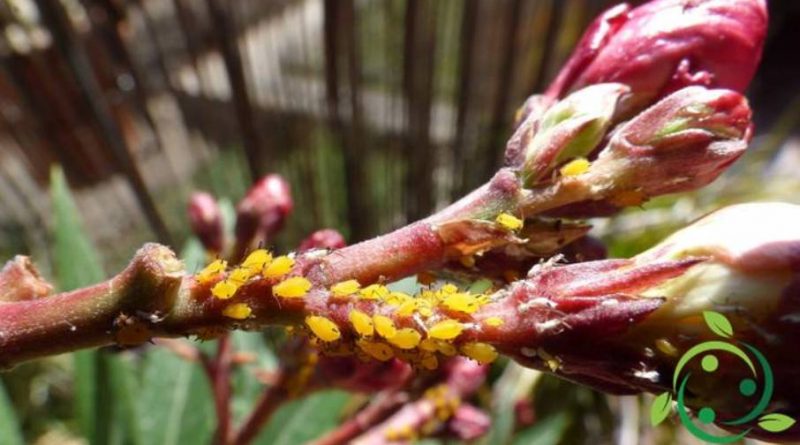Mechanism of action of insecticidal mineral oils
Mechanism of action of insecticidal mineral oils
Insecticidal mineral oils are a class of products derived from the fractional distillation of crude oil, which are used in agriculture for their insecticidal action.
The mechanism of action of the insecticidal oil is physical and non-chemical: insects such as mealybugs and many others breathe thanks to orifices positioned along the abdomen, which in entomology are called stigmas or tracheal spiracles .
When a part of the plant is sprayed with insecticidal mineral oils they cover the stigmas; in these conditions the insects can no longer breathe and suffocate and die.
Insecticidal mineral oils, in the composition of which aliphatic hydrocarbons with high molecular weight (paraffins) and aromatic form part, nevertheless exert their biological action both on plants (phytotoxicity) and on insects (insecticidal action). Phytotoxicity is consequent to the penetration by capillarity into the plant tissues, while the insecticidal action is due to the occlusion of the tracheal spiracles with consequent death of the insect by asphyxiation.
In general, the aromatic compounds are phytotoxic or have no insecticidal action, therefore paraffins must prevail in the composition.
The action of the aliphatic components is different in which the insecticidal action and phytotoxicity are associated with the molecular weight. Paraffins with a molecular weight lower than 280-290 u have a modest insecticidal action, those with a molecular weight higher than 330-340 u are phytotoxic. Unsaturated hydrocarbons, on the other hand, have a more energetic action both in the insecticidal effect and in the phytotoxicity.
In general, different classes of insecticidal mineral oils are distinguished according to the composition and the type of processing and refining. We will thus have:
– Anthracenic oils; these also called winter oils or brown oils or heavy oils, are mineral oils with a low degree of refining, therefore composed of a substantial portion of polynuclear and unsaturated aromatic hydrocarbons. Today, use for agricultural purposes is no longer allowed for reasons of environmental and health impact, due to their potential for carcinogenic risk. These oils have a reddish-brown color and low volatility, therefore they stay longer on plants. Their repeated use required periodic treatments with polysulphides in order to remove the oily patina. In addition to the high insecticidal action, anthracenic oils have a marked phytotoxicity, and could only be distributed on deciduous tree plants during winter rest (hence the name of winter oils).
– White oils; also defined as white oils or light oils, they are the mineral oils obtained from a refining process, therefore they have a high content in saturated hydrocarbons, with UR of at least 95-96. In this process, refining eliminates the red-brown coloring of mineral oils, giving way to a milky white color, hence the name attributed to these products. White oils are more volatile, therefore they stay for much shorter times on the surface of plants. Ultimately they have a rather low phytotoxicity therefore they can also be used for spring treatments on plants in vegetation. These oils have a much lower environmental and health impact. Under certain constraints, they are also compatible with organic agriculture (treatments to be carried out by March 31 only on arboreal fruit trees and upon the need proven by the Phytosanitary Observer). However, they exhibit a much milder insecticidal action and this is the reason why, against certain insects, they are used in combination with other insecticides, mostly phosphorganic (activated white oils) capable of acting also by contact or by ingestion.
– Yellow oils; this category includes a mixture composed of mineral oils and DNOC. DNOC (4,6-dinitro-ortho cresol) is a plant protection product of the class of nitrogen dinitrophenols. This product, whose agricultural use is no longer allowed, has been used as an insecticide, acaricide, fungicide and herbicide. Yellow oils therefore possess a high insecticidal power, as they combine the action by suffocation of mineral oils with that by contact of the DNOC; however, these products could be used, due to phytotoxicity, only for winter treatments, directed against the wintering forms of aphids and mealybugs. Their use was allowed on pome fruits and stone fruits. In this regard, please note that the use of all DNOC-based products, including therefore yellow oils, is revoked by Ministerial Decree of 4 June 1999 in implementation of EU Directive no. 414 of 1991.
Mineral oils are routinely used in the fight against the less mobile forms of insects that have a pungent-sucking mouthparts; these include the cochineals, the aphids and the juvenile stages of the aleurodes. The presence of DNOC in yellow oils gave them a more effective action against the wintering eggs of mites and, above all, of aphids, while this action is much milder in white oils.
The area of use is fruit growing (pome and stone fruit) and citrus growing. Currently the exclusive use of white oils is allowed.
As for toxicity towards humans or other mammals, once anthracenic oils are no longer allowed, mineral oils have a toxicity level that depends on the presence of other insecticides. Light oils have a very low health impact, therefore white oil formulations are considered unclassified or at best irritating.
Yellow oils, on the other hand, have a much higher toxicity due to the presence of DNOC, which is why commercial formulas, no longer on the market since 2000, were classified as toxic.
However, the use of insecticidal mineral oils must always and in any case be commensurate with the presence of other insects and their biocoenoses.

